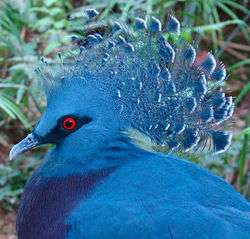Crowned pigeon
| Crowned pigeons | |
|---|---|
 | |
| Victoria crowned pigeon | |
| Scientific classification | |
| Kingdom: | Animalia |
| Phylum: | Chordata |
| Class: | Aves |
| Order: | Columbiformes |
| Family: | Columbidae |
| Genus: | Goura Stephens, 1819 |
The three species of crowned pigeons (Goura) – the western crowned pigeon (Goura cristata), the southern crowned pigeon (Goura scheepmakeri) and the Victoria crowned pigeon (Goura victoria) – are the largest extant pigeons (Columbidae). The three crowned pigeons are alike and replace each other geographically. The genus was described by James Francis Stephens in 1819.
Systematics and evolution
The phylogeny of the crowned pigeons is not well resolved. Several molecular analyses have been conducted (e.g. Johnson &, 2000), with one (Shapiro et al., 2002) suggesting that along with the Nicobar pigeon and the tooth-billed pigeon of Samoa, the three Goura pigeons belong to a group of which the unfortunate dodo and the Rodrigues solitaire are an offshoot lineage, but depending on which genetic sequence is analyzed, the placement of the crowned pigeons differs. They might belong to the Treroninae subfamily of the fruit-doves, but usually they are treated as a subfamily of their own, the Gourinae.
The following cladogram, from Shapiro and colleagues (2002), shows their closest relationships within Columbidae, a clade consisting of generally ground-dwelling island endemics.[1]
| |
| ||||||||||||||||||||||||||||||
| |
A similar cladogram was published in 2007, differing only in the inverted placement of Goura and Didunculus, as well as in the inclusion of the pheasant pigeon and the thick-billed ground pigeon at the base of the clade.[2]
Description
They are natives of New Guinea and a few surrounding islands. They forage on the forest floor eating fallen fruit, seeds and snails. The males and females are almost identical, but during courtship the male will coo and bow for the female. Both parents incubate one egg for 28 to 30 days and the chick takes another 30 days to fledge. The life span can be over 20 years.
References
- Johnson, Kevin P.; Clayton, Dale H. (2000). "Nuclear and Mitochondrial Genes Contain Similar Phylogenetic. Signal for Pigeons and Doves (Aves: Columbiformes)" (PDF). Molecular Phylogenetics and Evolution. 14 (1): 141–151. doi:10.1006/mpev.1999.0682. PMID 10631048.
- Pereira, S. L.; Johnson, K. P.; Clayton, D. H.; Baker, A. J. (2007). "Mitochondrial and nuclear DNA sequences support a Cretaceous origin of Columbiformes and a dispersal-driven radiation in the Paleogene". Systematic Biology. 56 (4): 656–672. doi:10.1080/10635150701549672. PMID 17661233.
- Shapiro, B.; Sibthorpe, D.; Rambaut, A.; Austin, J.; Wragg, G. M.; Bininda-Emonds, O. R. P.; Lee, P. L. M.; Cooper, A. (2002). "Flight of the Dodo" (PDF). Science. 295 (5560): 1683. doi:10.1126/science.295.5560.1683. PMID 11872833. Supplementary information